You’ve seen the rest of the year-end lists. You know their story: compiled more from group-think than a list of purely amazing albums. So, as one of the final lists to go online, we’ve saved the best for last.
Presented in chronological order of release, the following 51 albums pull from the acclaimed and the unsung — some of the best as well as most boundary-pushing releases from rock and beyond.
Want to see our very favorites? Head here for our 11 favorite albums of 2013.
 Brokeback: Brokeback and the Black Rock (Thrill Jockey, 1/22/13)
Brokeback: Brokeback and the Black Rock (Thrill Jockey, 1/22/13)
“The Wire, the Rag, and the Payoff”
Brokeback: “The Wire, the Rag, and the Payoff”
With more than a little reverb, a sense of wide-open space, and a strong kinship with Americana, Brokeback and the Black Rock is what instrumental albums should be. There is no struggle with absent vocals; these are complete compositions, finished and evocative.
Founder Douglas McCombs of Tortoise has, on this album, collaborated more fully than ever before. Whereas previous Brokeback outings featured occasional guest artists, this LP — the group’s first in 10 years — enlists a core group to back up McCombs. And things soar.
With twangy fuzz, Western touches, and a greater rock aesthetic, Brokeback hasn’t changed what worked, instead using it as a jump-off to its evolution.
– Lincoln Eddy
 Tomahawk: Oddfellows (Ipecac, 1/29/13)
Tomahawk: Oddfellows (Ipecac, 1/29/13)
“Oddfellows”
Putting the “rock” back in “rock super-group,” Tomahawk makes a mighty return with Oddfellows, a “re-launch” of a band whose last album (Anonymous in 2007) was an aggressive interpretation and expansion of Native American motifs.
The group’s core — singer/sampler Mike Patton (Faith No More), guitarist Duane Denison (The Jesus Lizard), and drummer John Stanier (Battles) — is now joined by bassist Trevor Dunn (Mr. Bungle), resulting in tunes with even more muscle and flexibility. Pugilistic riffs are front and center once more, but Patton expands the band’s range with “heavy pop” vocals — including some downright cooing — for soaring choruses.
There are a few other twists and turns, including a jazzy organ here and a deep piano melody there, but the band is still founded on those vocals over winding melodies, thick bass tones, and pounding, syncopated beats. Don’t believe us; hear it for yourself. Oddfellows is one of the best albums of 2013.
– Scott Morrow
 The Bronx: (IV) (White Drugs / ATO, 2/5/13)
The Bronx: (IV) (White Drugs / ATO, 2/5/13)
“Ribcage”
After a few albums of Mexican folk rock as Mariachi El Bronx, The Bronx is back to bleed ears with its punk-band incarnation. From the opening salvo of guitar to the last shouted vocal, (IV) is gutter-dirty, anger-fueled punk rock.
With a feel that wouldn’t be out of place in the ’80s, this is a fast album, with only one song breaking four minutes and most lyrics delivered between a growl and a scream. The closest thing to a ballad is “Life Less Ordinary,” which reads more like a breakdown, giving listeners just a moment to catch their breaths before the circle-pit spin to the end. Frantic and violent, (IV) should be heard with the volume cranked.
– Lincoln Eddy
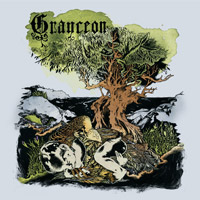 Grayceon: Pearl and the End of Days (The Flenser, 2/12/13)
Grayceon: Pearl and the End of Days (The Flenser, 2/12/13)
“Pearl”
As the art of the full-length grows weaker with the rise of the digital era, 30 minutes of music practically qualifies as a double album for some artists. Not so for cello-metal trio Grayceon, whose EP Pearl and the End of Days nearly hits a half-hour in just two epic tracks.
“Pearl,” the first of those two, is 10 minutes worth of tension, release, and riffs. Jackie Perez-Gratz’s transformative cello syncs with Max Doyle’s deep guitar licks and Zack Farwell’s double-bass and tom-heavy drumming to cut swaths through the moody intro. Meanwhile, Gratz’s and Doyle’s vocals alternate between delicate and brutal, giving “Pearl” a warmth to pair with the sheer metal aggression.
As for “End of Days,” its 17 minutes are practically an EP unto itself, with long, ringing chords turning to somber yet busy melodies, alternately Rasputina-like vocals and metal shrieking, and, of course, massive metal riffs. Few releases can do so much with two tracks. Get this now.
– Scott Morrow
 Shai Hulud: Reach Beyond the Sun (Metal Blade, 2/19/13)
Shai Hulud: Reach Beyond the Sun (Metal Blade, 2/19/13)
“Reach Beyond the Sun”
Shai Hulud: “Reach Beyond the Sun”
In 1997, Shai Hulud released a debut LP, Hearts Once Nourished with Hope and Compassion, that became a cult favorite and helped define the landscape of metalcore. Led by guitarist Matt Fox, its mathy hardcore was melodic yet frenetic, topped by the blistering, gravelly screams of Chad Gilbert.
But Gilbert, who was just 16 at the time, eventually left to found pop-punk quintet New Found Glory, and Shai Hulud ended up rotating vocalists on its two subsequent full-lengths. Reach Beyond the Sun brings a long-awaited return, with Gilbert both producing and supplying vocals for 11 assailing songs of riff-borne fury and rancorous gang vocals.
Yet for as welcome a return as Gilbert’s vocals are, Fox’s winding, chugging riffs are the star, turning any number of directions but never losing urgency or melody. Whether or not you were a fan back in the day, pick this up.
– Scott Morrow
 Ill Bill: The Grimy Awards (Uncle Howie / Fat Beats, 2/26/13)
Ill Bill: The Grimy Awards (Uncle Howie / Fat Beats, 2/26/13)
“Paul Baloff”
Leave it to one of the elder statesmen of the Brooklyn hip-hop scene to teach a few lessons.
Ill Bill, with the help of a cadre of collaborators and producers, brings his powerhouse flow and boom-bap arrangements to The Grimy Awards — an album that serves as equal parts biography and wake-up call for a new generation. Unlike many rap albums where topics of violence and drugs are used as the crutch of an uncreative artist, Bill infuses his tales of a gritty Brooklyn upbringing with an insistence to question the corrupt institutions that plague us on tracks like “Severed Heads of State” and “Truth.”
El-P, HR of Bad Brains, Jedi Mind Tricks, and A-Trak are just a few of the artists who help to complement Ill Bill’s sledgehammer delivery. And with the backing of New York producing legends like Large Professor and Pete Rock laying hard-hitting drums over a wide range of samples (classical, orchestral, R&B, rock), The Grimy Awards strikes a balance between style and substance that makes the album worthy of revisiting.
– Adam Redling
 How to Destroy Angels: Welcome Oblivion (Columbia, 3/5/13)
How to Destroy Angels: Welcome Oblivion (Columbia, 3/5/13)
“How Long”
How to Destroy Angels: “How Long”
In 2010, Nine Inch Nails leader Trent Reznor launched a new project, How to Destroy Angels, with wife Mariqueen Maandig and collaborator Atticus Ross (who is co-credited with Reznor on The Social Network and The Girl with the Dragon Tattoo soundtracks). The group’s first two EPs contained familiar Reznor melodies and “post-industrial” elements, but with an expanded palette of metallic and organic timbres, which paired well with the synthetic swirls and swells as well as Maandig’s breathy vocals.
On the group’s debut LP, Maandig’s vocals have a wider range and do a better job of leading, and there’s better interplay between her and Reznor, notably on lead single “Keep It Together.” Like NIN’s The Fragile or Ghosts I–IV, a good chunk of Welcome Oblivion is softer — more atmospheric — but mixed with cuts like “How Long,” a modernized blast of electro-pop. Four tracks here are repeats from the EPs, but they’re standouts that many will hear for the first time. Introduce yourself.
– Scott Morrow
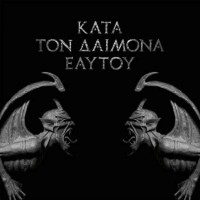 Rotting Christ: Kata Ton Daimona Eaytoy (Season of Mist, 3/5/13)
Rotting Christ: Kata Ton Daimona Eaytoy (Season of Mist, 3/5/13)
“In Yumen / Xibalba”
Rotting Christ: “In Yumen / Xibalba”
A progenitor of Grecian black metal in the early 1990s, Rotting Christ has done more than merely spread a Scandinavian style across the Mediterranean. Each subsequent release has evolved from its predecessor, and the Athens band’s past two albums — Theogonia in 2007 and Aealo in 2010 — have channeled its heritage, tying chants, choirs, and bagpipes to gothic metal.
Translating loosely to “do what thou wilt,” Kata Ton Daimona Eaytoy is an apt title for a band playing by its own rules. Its 11 tracks, which use poetry and folk lyrics from indigenous and olden cultures, are an engaging blend of mid-tempo chugging, upper-string black-metal melodies, rock riffs, and deep, elongated vocalizations. Put up those horns…if thou wilt.
– Scott Morrow
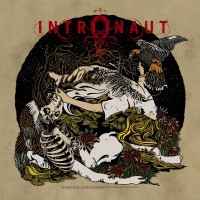 Intronaut: Habitual Levitations (Instilling Words With Tones) (Century Media, 3/19/13)
Intronaut: Habitual Levitations (Instilling Words With Tones) (Century Media, 3/19/13)
“Milk Leg”
Now on its fourth full-length album, Los Angeles’s Intronaut has been a lesser-known gem of progressive sludge metal for the past eight years. Valley of Smoke, the band’s 2010 album, was a colossal effort, and Habitual Levitations picks up where it left off — only with a higher profile and a stronger sense of dynamics.
Mathy and polyrhythmic, the nine epic jams herein excel by contrasting light and dark, beautiful and melancholy — with technical prowess that’s impressive within the songwriting framework. There are similarities to Isis’s Panopticon in the melodic, harmonized vocal passages, clean-channel guitars, and electric-bass tones, not to mention the mid-tempo sludge, but the album features plenty of brutality and tight-as-nails prog drumming. If you’re still unfamiliar, don’t be for long.
– Scott Morrow
 And So I Watch You From Afar: All Hail Bright Futures (Sargent House, 3/19/13)
And So I Watch You From Afar: All Hail Bright Futures (Sargent House, 3/19/13)
“Like a Mouse”
And So I Watch You From Afar: “Like a Mouse”
The mighty Sargent House label / management company has made a habit of plucking talent from wherever it pleases, and Belfast, Northern Ireland, was the destination for one of its newest additions, the euphoric math-rock group And So I Watch You From Afar.
Now, following a re-release of the last ASIWYFA album in the States, the fearless label has released the band’s brand-new dose of über-melodic mega riffs and head-banging, torso-pummeling rhythms. Glistening guitar textures and extra-thick bass licks again lead the way, but there are more than a few simple and harmonized vocal refrains to go with intermittent usage of voice as texture. And with sonic switcheroos in the form of trumpet, flute, and synthesizers, the latest from ASIWYFA announces the band’s own bright future.
– Scott Morrow
 Finntroll: Blodsvept (Century Media, 3/26/13)
Finntroll: Blodsvept (Century Media, 3/26/13)
“Blodsvept”
Originally spawned to pair Finnish folk music with black and extreme forms of metal, Helsinki’s Finntroll has spent five (now six) albums expanding its trademark sound, growing more cinematic, cartoonish, worldly, and melodic. Blodsvept, though still first and foremost a metal album, continues the trend of no two songs being alike, with film-score motifs, circus elements, and psychobilly joining the trashing, chugging, speed-picking madness.
“Mordminnen” (translation: “murder memories”) sounds like a crunchy rendition of the Inspector Gadget theme. Banjo and guitar offer synchronized shredding on “Skogsdotter,” Tom Waits-ian vocal rumblings appear late on the folksy “Rösets Kung,” and horns play an important supporting role throughout, most notably on the groovy and ghoulish “Häxbrygd.”
As a result, Blodsvept — like its predecessors — inches ever closer to a fully realized Finntroll.
– Scott Morrow
 Trollfest: Brumlebassen (NoiseArt / Napalm, 3/26/13)
Trollfest: Brumlebassen (NoiseArt / Napalm, 3/26/13)
“Illsint”
How often can one say that it’s an impossibly great week for Scandinavian metal, let alone Scandinavian troll-themed folk metal? Unlike its Finnish contemporaries in Finntroll (whose vocalist, Vreth, makes an appearance here), Norway’s Trollfest has remained fully invested in its folk elements, albeit with a broader map.
The band’s fifth full-length is another jaw-dropping combination of raging tempos and thrash and melodic death-metal riffs with Balkan melodies, group chanting, and troll-related silliness. Greek bouzouki gives a metallic twang and Mediterranean vibe to tracks such as “Illsint,” while accordion, banjo, xylophone, and more offer accents throughout.
Though the album’s momentum is derailed by a pair of jokey acoustic songs and a tongue-in-cheek radio-metal song about selling out, the rest of it will leave your mouth agape. And amid a plethora of modern folk- and pagan-metal groups who play it straight, it’s nice to see a band that isn’t afraid to have a goofy good time.
– Scott Morrow
 Zozobra: Savage Masters (Brutal Panda, 4/2/13)
Zozobra: Savage Masters (Brutal Panda, 4/2/13)
“Venom Hell”
Built on distorted low-end riffs, punishing rhythms, and vocal brutality, Zozobra is the brainchild of bassist/singer Caleb Scofield (Cave In, Old Man Gloom). Savage Masters, the band’s third album and first since ’08, is a wicked resurrection, now boasting Cave In bandmates Adam McGrath (guitar) and JR Conners (drums) and bearing the influence of old punk and hardcore favorites.
The result is a blistering cannon of short, straight-to-the-point songs that lasts right around 15 minutes. It’s a diversion from Zozobra’s first two records that, while heavy, were slower paced and more drawn out. Savage Masters is the hands-down scorcher of the trilogy — the fiercest record in the band’s litany.
– Oakland L. Childers & Scott Morrow
 Tera Melos: X’ed Out (Sargent House, 4/16/13)
Tera Melos: X’ed Out (Sargent House, 4/16/13)
“Tropic Lame”
It’s all too common for bands to betray their original mission when they embrace pop or “mellow out.” On X’ed Out, Sacramento post-prog trio Tera Melos proves it’s possible for even the most technically proficient artists to focus on conventional song structure without losing their edge.
Bassist Nathan Latona described some of the new material to ALARM as “toned down,” but in this case, “toned down” is a relative term. True, Tera Melos has never emphasized melody or space to this degree, but X’ed Out still falls quite far from the middle of the road, and longtime fans shouldn’t worry about this music landing on the radio anytime soon.
Even at its most spastic, Tera Melos has always demonstrated a knack for cohesion that’s rare among its math-minded peers. On X’ed Out, the band harnesses its prodigious chops with such skill and vigor that the restraint actually feels thrilling. If X’ed Out is any indication, Tera Melos won’t be out of new ideas or directions for a long, long time.
– Saby Reyes-Kulkarni
 Ghost BC: Infestissumam (Universal Republic, 4/16/13)
Ghost BC: Infestissumam (Universal Republic, 4/16/13)
“Secular Haze”
If there’s any evidence of Satan’s power, it’s the way Ghost BC manages to make the dark lord’s message so sweetly irresistible. On Infestissumam, the band’s second release, these occult-obsessed Swedes plunge their radio-friendly hooks even deeper, once again delivering glossy, sing-a-long experi-metal that isn’t afraid to be catchy.
Like the 2010 debut Opus Eponymous, the new record is spiff with harmonized vocal arrangements, cathedral synthesizers, and anthemic, groove-oriented riffs. Perhaps the biggest difference is the band’s willingness to go farther into uncharted territory for a more eerie, ethereal sound, adding prominence to its new-wave and classic-rock influences. That transition from dream to doom is seamless on “Ghuleh / Zombie Queen,” as it is throughout Infestissumam as a whole.
Of course, Ghost BC sells Satanism with a straight face and, as such, remains lyrically and sonically dark even at its brightest. That’s what’s so fun about this band’s commercial viability: it could play a roller rink…or a church burning.
– Josh Stockinger
 Ceramic Dog: Your Turn (Northern Spy, 4/30/13)
Ceramic Dog: Your Turn (Northern Spy, 4/30/13)
“Lies My Body Told Me”
Ceramic Dog: “Lies My Body Told Me”
Guitarist Marc Ribot is a man so prolific that it’s impossible to assign him a genre. Whether rock, jazz, world, or experimental, his music always bears the mark of a master.
Ceramic Dog, his outfit with Shahzad Ismaily and Ches Smith of Secret Chiefs 3, plays a brand of guitar-driven experimental rock that would seem disjointed in lesser hands. Your Turn, the group’s second album, puts the band’s diversity on display — from the bluesy cursing of physiology in “Lies My Body Told Me” to the winding, polyrhythmic title track to wailing psych solos to “free rock” freakouts and a rock rendition of Dave Brubeck’s “Take Five.”
Elsewhere, Ribot’s raspy vocals lead the quirky ditty “Ain’t Gonna Let Them Turn Us ‘Round,” the old-school jazz feel of “The Kid is Back!”, and the horn- and electronics-infused “We Are the Professionals.” As always, Ribot’s virtuosity is on display throughout — but there are plenty of pleasant diversions and surprises along the way.
– Scott Morrow
 The Dillinger Escape Plan: One of Us Is the Killer (Sumerian, 5/14/13)
The Dillinger Escape Plan: One of Us Is the Killer (Sumerian, 5/14/13)
“Nothing’s Funny”
The Dillinger Escape Plan: “Nothing’s Funny”
Influenced by old punk and hardcore albums and devoid of full-blown sonic excursions, The Dillinger Escape Plan’s fifth full-length album is, if there is such a thing, a “straightforward” affair. Raging, intricate blasts of metalcore mayhem still rule One of Us Is the Killer, but with only one “radio-friendly” track, no epic piano jams, and most songs under four minutes, it’s pure adrenaline — and still adventurous as all get out.
Featuring the same recording lineup, the band now benefits from better chemistry between guitarist/songwriter Ben Weinman and drummer Billy Rymer, not to mention an even wider range from vocalist Greg Puciato, who works from eruptive anger to cooing, crooning, chanting, and even spoken (and shouted) word. Sonically, it’s still über-diverse, with bits of glockenspiel, piano, horns, “choir” effects, and keyboard squiggles, plus a “dark bossa nova” interlude, an instrumental synth jam, and an organic drum-and-bass intro.
With it all said and done, One of Us Is the Killer — with Dillinger as mind-blowing as ever — is one of the best albums of 2013.
– Scott Morrow
 NK: Nothing to Be Gained Here (Triple Crown, 5/21/13)
NK: Nothing to Be Gained Here (Triple Crown, 5/21/13)
“Shoulder Gorilla”
As music lovers, we await those rare projects that combine familiar and new elements in unique, indescribable ways. Comprised of singer/guitarist Ryan Hunter (Envy on the Coast), bassist Michael Sadis (The Rivalry), and drummer Billy Rymer (The Dillinger Escape Plan), NK is one of those projects.
Nothing to Be Gained Here, the group’s debut album, is a mash of Deftones-style groove riffs, heavy hip hop, shoegaze, post-punk, and soulful down-tempo jams, topped by Hunter’s alternate croons and weirdo half-raps. On “Shoulder Gorilla,” he channels his inner Mike Patton — specifically, Patton’s collaboration with The X-Ecutioners — as dirty synths and dirtier guitars bang heads across the land.
Rymer is more reined in than on his work with Dillinger, but his beats deftly align with the album’s many moods — and, most importantly, those heavy grooves. Nothing to Be Gained Here deserves a spot on these coveted year-end lists. Don’t sleep on it.
– Scott Morrow
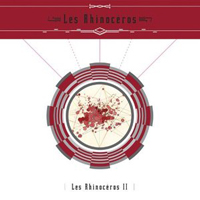 Les Rhinocéros: II (Tzadik, 5/21/13)
Les Rhinocéros: II (Tzadik, 5/21/13)
“Bea Spiders”
Formed in 2008 as an improvisational bass-and-sax project, Les Rhinocéros continues its transformation to a focused yet experimental rock band on this, its second album as a power trio.
Chosen by legendary composer John Zorn to start his label’s “spotlight series,” the band commingles progressive rock with jazz, worldly melodies, and other tangents. Thankfully, nothing seems forced — switching from winding riffs to Jewish-inflected dub and fading into flickering drone is a logical progression. Song titles speak to their content: “Echidna” is an outback populated by didgeridoos and the titular animal; “Life in a Battery” delivers a spoken-word concept over a lonely string motif. These songs may be individual compositions, but when viewed together, they’re a catalog of exciting, interwoven ideas.
– Lincoln Eddy
 Scout Niblett: It’s Up to Emma (Drag City, 5/21/13)
Scout Niblett: It’s Up to Emma (Drag City, 5/21/13)
“Gun”
Dour yet inspiring, Scout Niblett’s music has the visceral impact of splinter removal: it’s bloody, and it may hurt, but it’s therapeutic. On It’s Up to Emma, her sixth full album, Niblett bares her soul in songs that convey the raw intensity of personal shakeups.
The album opens with “Gun,” a song that instills terror, pity, and rage in the listener. In a microcosm of the album’s seething catharsis, deadly vengeance is threatened on a cheating lover. From thereon, each song branches with emotional pitfalls. Even TLC’s “No Scrubs” is taken from playful “fuck off” to stripped-down anthem. As usual, the production is spare, with interspersed beats and strings accompanying Niblett’s powerful voice and bluesy rock riffs — yielding a beautiful and morose collection.
– Lincoln Eddy
 Shining: One One One (Prosthetic, 5/28/13)
Shining: One One One (Prosthetic, 5/28/13)
“I Won’t Forget”
When Norway’s Shining released Blackjazz in 2010, it marked more than a bold new direction in progressive metal — it was the final phase of transformation of a former acoustic jazz outfit that had delved into classical melodies, prog rock, and synth-driven industrial madness.
One One One, the latest from Shining songwriter Jørgen Munkeby, isn’t another shock to the system; instead it refines and streamlines, pairing more rock-’n’-roll grooves, blazing tempos, and traditional song structures with the brutality. The tracks here are all “ones” — each a singularly digestible piece, each a miniature masterpiece of metallic, fist-pumping avant-rock.
– Scott Morrow
 Retox: YPLL (Epitaph, 5/28/13)
Retox: YPLL (Epitaph, 5/28/13)
“Congratulations, You Are Good Enough”
Retox: “Congratulations, You Are Good Enough”
Though Retox vocalist Justin Pearson (of The Locust) gets first mention for his name recognition, the rest of this Southern California hardcore-punk outfit is no less tenured or talented, with other projects that span from noise-core to Americana.
YPLL, the band’s sophomore “LP” — which hits 22 minutes after just 13 on the band’s freshman affair — is another dose of high-speed aggression and witty/pithy song titles (“Greasy Psalms,” “Soviet Reunion,” “Congratulations, You Are Good Enough”). New addition Brian Evans suitably replaces the whirling-dervish Gabe Serbian on drums, and with only two tracks on YPLL that eclipse two minutes, his maniacal energy is crucial. Whether you’ve followed the lineage of Pearson’s Three One G label or just love riotous punk rock with smarts, pick this up.
– Scott Morrow
 Queens of the Stone Age: …Like Clockwork (Matador, 6/4/13)
Queens of the Stone Age: …Like Clockwork (Matador, 6/4/13)
“My God Is the Sun”
Queens of the Stone Age: “My God Is the Sun”
Named after a propensity for its recording to be derailed “like clockwork,” the first album in six years from Queens of the Stone Age finds front-man Josh Homme returning to his primary outfit following records with Them Crooked Vultures and Eagles of Death Metal.
Off the bat, it seems like vintage QOTSA, with alternately cagey and classic rock-’n’-roll riffs topped by Homme’s wavy, reverberated vocals that shift in and out of falsetto. But the album’s style quickly expands from there, and it’s not just due to high-profile guest appearances by Trent Reznor, Dave Grohl, Elton John, Mark Lanegan, and other frequent collaborators. Swelling synths and a bouncy bass line lead “The Vampyre of Time and Memory,” a spacey and ever-so-jazzy intro/bridge mark “Kalopsia,” and a-cappella harmonies introduce “Fairweather Friends.”
Just as on its predecessors, …Like Clockwork benefits from a wide and unique palette of guitar tones — best exemplified by the alien-harmony effects on the slinky, stomping “Smooth Sailing.” They also soup up the hard-charging moments, which, despite a few down-tempo jams, are plentiful. With all told, …Like Clockwork is a welcome return.
– Scott Morrow
 Deafheaven: Sunbather (Deathwish, 6/11/13)
Deafheaven: Sunbather (Deathwish, 6/11/13)
“Sunbather”
Since its birth in 2010, San Francisco’s Deafheaven has received hefty praise for its shoegazing black-metal creations — joining a new cadre of well-received post-black-metal-heads like Liturgy and Nachtmystium.
On Sunbather, the band’s second LP, the core creative duo of vocalist George Clarke and guitarist Kerry McCoy are joined by new drummer Daniel Tracy, who propels 60 minutes of brutality and melody with a frenzied yet balanced approach. The biggest difference, however, is the sheer beauty and clean-channel guitar tones that are interspersed throughout the sonic assault — landing the band closer to “screamo” territory at times, and recalling its pair of Mogwai covers from last year’s split release with Bosse-de-Nage.
Sunbather’s longer tracks are separated by shorter cuts (still three to six minutes), and the alternation controls the dynamics and flow so well that it could make any impatient ‘tween into a post-metal fan. All of the band’s familiar elements are present, but by honing its style and treating the album like theater — with proper cues, scenes, interludes, and finales — Deafheaven has made its sophomore release into a metal masterpiece.
– Brandon Goei
 The White Mandingos: The Ghetto’s Tryna Kill Me (Fat Beats, 6/11/13)
The White Mandingos: The Ghetto’s Tryna Kill Me (Fat Beats, 6/11/13)
“Warn a Brotha”
The White Mandingos: “Warn a Brotha”
With a name that would have given Tipper Gore an embolism if it had been around in 1985, The White Mandingos is the rap-core heir you’ve been hoping for since Ice-T’s Body Count dropped “Cop Killer” in 1992.
Comprised of rapper front-man MURS, Bad Brains bassist Darryl Jenifer, and Ego Trip co-founder Sacha Jenkins, the band is a different musical blend — mixing the Brains’ hardcore (and touches of its reggae/dub) with hip hop, rock and roll, R&B, and old-school grooves. As such, the trio is here to confound expectations and make some of the most unique music of the year.
As the name and title indicate, race plays a major part in the Mandingos’ debut, a concept album built around the fictional Tyrone White’s struggles as a Harlem-based rock front-man. The record becomes a collection of short stories, with “Black Girl Toof,” “What You Waitin’ On,” and “Mandingo Rally” as incisive slices of the personal and political.
So what is The White Mandingos? It’s the #swag-destroying title track, the piss-taking cover of Minor Threat’s “Guilty of Being White,” and a subversive modern manifesto on wax.
– Lincoln Eddy
“Patagonia”
Have you ever imagined Deftones singer Chino Moreno fronting post-metal cult heroes Isis? This rhetorical question is a lesson in Oversimplification 100, but it’s an apt introduction to Palms, a new super-group with Mr. Moreno and 3/5 of Isis (no Aaron Turner, FYI).
The music on this self-titled debut — with six tracks reaching 47 minutes — isn’t quite as metallic as the members’ more famous bands, but it very much resembles the melodic, epic, reverberated jams of later Isis albums. It isn’t all soft by any means — guitar fuzz still features prominently, and Moreno’s breathy croons climax in throatier howls. The result is weighty and pretty, and for fans of modern post-metal with legit singing, Palms is a name to remember.
– Scott Morrow
 Chthonic: Bú-Tik (Spinefarm, 6/25/13)
Chthonic: Bú-Tik (Spinefarm, 6/25/13)
“Defenders of Bú-Tik Palace”
Chthonic: “Defenders of Bú-Tik Palace”
Formed in Taipei in 1995, Chthonic (pronounced “thonic”) plays symphonic metal rooted in traditional Taiwanese music and folklore. Elements of thrash, black, power, and melodic death metal play alongside the emotional cries of an erhu (a traditional two-string bowed fiddle) and vocalist Freddy Lim’s piercing shrieks and guttural screams.
Continuing the band’s tradition of addressing Taiwanese history and mythology, Bú-Tik is based on the story of the 228 Massacre of 1947, the slaughter of anti-government protesters at the hands of the Republic of China.
Musically, the album ratchets up the fury, adding raging rock solos that wail, squeal, and harmonize on nearly every track. Epic chants, stringed accompaniment, and intros/outros maintain a balance, but the speed riffs operate at full bore. Don’t miss one of the best metal albums of the year.
– Scott Morrow
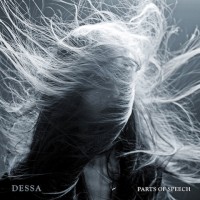 Dessa: Parts of Speech (Doomtree, 6/25/13)
Dessa: Parts of Speech (Doomtree, 6/25/13)
“Warsaw”
Parts of Speech is as much a polymath as Dessa herself. A noted lecturer, spoken-word artist and singer, poet/essayist, and member of the Doomtree hip-hop collective, Dessa holds an eclectic background that coalesces in her work. Her third full-length keeps some of Castor, the Twin’s echoing orchestrals but splices in electronic DNA; balladry and beats share space, with symbiosis akin to Dessa’s mix of spitting and crooning.
“The Man I Knew” and “Call Off Your Ghost” set up this relationship, as letters to a former lover are backed by live-band melodicism and skittering kicks, respectively. A bared Dessa lives in her lyrics; each song is another layer shown, her voice alternately purring and cutting. Parts of Speech is a self-portrait: a person loving, posturing, vulnerable, and imperfectly beautiful.
– Lincoln Eddy
 Run the Jewels: Run the Jewels (Fool’s Gold, 6/26/13)
Run the Jewels: Run the Jewels (Fool’s Gold, 6/26/13)
“Banana Clipper”
Run the Jewels: “Banana Clipper”
El-P and Killer Mike, the collaborators behind Run the Jewels, are reason enough to grab its self-titled first album. What you’re getting is rap perfection, El-P’s signature dark production mixed with what sounds like the electronics section of a Goodwill, underlining raging verses from both MCs.
With few guests and production that strikes the perfect balance of deep and minimalist, it’s steeped in the outsider aesthetics that have made these artists’ albums so special. Sounding off balances with Southern gangster posturing for some of the best bangers of the summer and one of the best rap albums of the year.
– Lincoln Eddy
 The Octopus Project: Fever Forms (Peek-A-Boo, 7/9/13)
The Octopus Project: Fever Forms (Peek-A-Boo, 7/9/13)
“Sharpteeth”
The Octopus Project: “Sharpteeth”
Over the past decade, Austin’s The Octopus Project has built a portfolio of electronics-infused post- and indie rock, with each of its four multi-instrumentalists (the eight arms of the octopus) contributing in different ways for each song.
Following the video-synchronized Hexadecagon experience, Fever Forms is full of dense, danceable rock jams with glistening electronics, dirty guitars, and the occasional glockenspiel, music box, or handclap. It’s just as buoyant but more direct — and it rocks harder. Simply put, Fever Forms is a gem of progressive pop rock.
– Scott Morrow
 Fuck Buttons: Slow Focus (ATP, 7/23/13)
Fuck Buttons: Slow Focus (ATP, 7/23/13)
“The Red Wing”
UK electronic duo Fuck Buttons quickly came to prominence with a pair of lauded albums in 2008 and 2009. And despite major pub for having a few tracks used during the 2012 London Olympics, it’s been a quiet few years for a seriously talented act.
Slow Focus is another step in the duo’s songwriting evolution — able to make eight-plus minutes of buildup and release pass in the blink of an ear. “Brainfreeze” works from a thumping beat, with textured and swirling synthesizers creating a beautiful, semi-industrial soundscape; “Year of the Dog” follows by pairing a Blade Runner-esque melody with nightmare-ish shrieks and a film-score choir effect.
The rest twists and turns between electronic effects, body-moving beats, and alternately poppy and progressive passages. Slow Focus might be the best electronic album of 2013.
– Scott Morrow
 Rabbit Rabbit: Rabbit Rabbit Radio, Vol. 1 (self-released, 8/6/13)
Rabbit Rabbit: Rabbit Rabbit Radio, Vol. 1 (self-released, 8/6/13)
“The Curious One”
Rabbit Rabbit: “The Curious One”
Each with boundary-pushing credits a mile long, wife-and-husband tag-team Carla Kihlstedt (Tin Hat, Sleepytime Gorilla Museum, 2-Foot Yard) and Matthias Bossi (SGM, The Book of Knots, Skeleton Key) are one of those consummate couples — the kind of musical pairing that belongs together.
Rabbit Rabbit Radio, Vol. 1 is a collection of their collaborative tunes, created for an audio/video subscription service, that’s full of omnivorous, risk-taking pop. The album’s first single, “The Curious One,” is a fitting representation of its diversity — built around a head-nodding groove, bouncing upright bass, glistening pizzicato plucks, deep distortions, and, of course, Kihlstedt and Bossi’s harmonized vocals.
– Scott Morrow
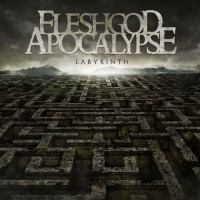 Fleshgod Apocalypse: Labyrinth (Nuclear Blast, 8/20/13)
Fleshgod Apocalypse: Labyrinth (Nuclear Blast, 8/20/13)
“Elegy”
Though less tenured than Mediterranean neighbors Septicflesh, Italy’s Fleshgod Apocalypse has been a quickly ascending name in symphonic, operatic death metal. Labyrinth is the band’s third full-length, and it’s another masterful effort — demonstrating endless technical talent whether via double-bass insanity, guitar-shredding madness, or piano-playing psychosis.
Yet despite the jam-packed riffs and beats, Fleshgod always demonstrates a knack for songcraft, balancing sonic brutality with symphonic strings and brass, marching snares, and piano runs, and alternating death growls with chants and operatic falsettos. The result is utterly epic.
– Scott Morrow
 Nine Inch Nails: Hesitation Marks (Columbia, 9/3/13)
Nine Inch Nails: Hesitation Marks (Columbia, 9/3/13)
“Copy of a…”
After a four-year hiatus, Nine Inch Nails returns with an album that reflects the laundry list of Trent Reznor’s life changes since he’s been away: marriage, parenthood, an Oscar-winning film score, and a new band, How to Destroy Angels. Hesitation Marks sounds like Pretty Hate Machine’s uncharacteristically happy bookend: synth-heavy and fully embracing its pop sensibility.
Fans more inclined toward the naked aggression of Downward Spiral-era NIN may bristle at the buzzy pop punk of “Everything” or “Satellite,” with its Electric Slide-ready chorus. But in truth, “Hesitation Marks” is less of a departure and more of a continuation of the straightforward radio rock of With Teeth in 2005 and the stripped-down direction of 2008’s The Slip. A defanged NIN? Perhaps. But also a NIN that isn’t living in the past.
– Keidra Chaney
 Chelsea Wolfe: Pain Is Beauty (Sargent House, 9/3/13)
Chelsea Wolfe: Pain Is Beauty (Sargent House, 9/3/13)
“We Hit a Wall”
Chelsea Wolfe: “We Hit A Wall”
Don’t make the mistake of hearing Chelsea Wolfe’s Pain Is Beauty without a headphone session. The range of sounds and the boost in sonic theatrics are breathtaking — “The Warden,” “Destruction Makes the World Burn Brighter,” and “Sick” offer up Eastern-sounding hammered dulcimers, vocal cooing over dirty and jangly guitar tones, and a dose of Berlin-era Bowie, all within the span of just three tracks.
Wolfe’s new album takes the intimate and creepy ponderings of previous release Apokalypsis and drastically expands and explores the space within each track. Previously, the songs were a collection of confessions told by a flickering campfire; now each track blazes and roars like a cliff-side bonfire.
– Brandon Goei
 Man Man: On Oni Pond (Anti-, 9/10/13)
Man Man: On Oni Pond (Anti-, 9/10/13)
“Pink Wonton”
For 10 years, quirk-rock quintet Man Man has delivered hooks, grooves, and throaty croons in a style like no other. The group’s fifth studio album, On Oni Pond, is described as a “band reboot,” merging its Tom Waits-ian, trop-pop weirdness with Talking Heads inspirations, old-school soul, and other oddities.
The album opens with the horn- and organ-driven boogie of “Pink Wonton,” a transfixing ditty. From there, the album blossoms with the marimba-and-bass infectiousness of “End Boss,” the stringy exotica of “Head On” (whose melody conjures Ritchie Cordell’s “I Think We’re Alone Now”), and the synthesized dub of “King Shiv.” “Loot My Body,” a heavy pop number, transforms into a tropical psych-jazz jam; “Deep Cover” is a ukulele-and-brass ballad; and “Pyramids” splices a dark-rock solo into an otherwise upbeat pop offering.
Continuing a streak of each album being even better than its predecessor, On Oni Pond is a wonderful “reinvention” — even if it’s still classic Man Man.
– Scott Morrow
 Felix Martin: The Scenic Album (Prosthetic, 9/17/13)
Felix Martin: The Scenic Album (Prosthetic, 9/17/13)
“Triangle Tune”
No, you’re not seeing double…you’re hearing double as well. Venezuelan guitarist Felix Martin is responsible for a multitude of double-takes thanks to his instrument of choice: a self-designed 14-string guitar (essentially, two guitar necks in one).
With virtuosic talent, he has taken the finger-tapping YouTube community by storm, performing progressive rock and metal with jazz-fusion overtones and elements of funk, world music, and even tinges of video-game and circus music. The Scenic Album, Martin’s second album and first for Prosthetic, is another diverse affair yet still a contemporary to Animals as Leaders and other finger-tapping prog-metal bands.
Speaking of the tapping, it’s nothing short of phenomenal. (Watch Martin’s many play-through videos if you haven’t.) He plays the über-wide-neck instrument like a piano, with one hand handling a bass line and the other handling a higher melody. But Martin also can simultaneously play chords on both necks, slap one and tap the other, or use them both for one mega-riff.
Accompanying Martin this time are rhythmic bass lines from fellow Berklee alumnus Nathan Navarro and bad-ass beats from industry vet Marco Minneman, who can drum for artists as different as Necrophagist and Joe Satriani. Their efforts makeThe Scenic Album more than a one-man show — even if Martin’s uncanny skills steal that show.
– Scott Morrow
 Trentemøller: Lost (In My Room, 9/24/13)
Trentemøller: Lost (In My Room, 9/24/13)
“Never Stop Running”
Trentemøller: “Never Stop Running”
On his last album, Danish electronic artist Anders Trentemøller transitioned from the dance world into a more organic, moody blend of analog and digital. Lost takes him one step further, weaving in and out of ambient electronica with another host of guest singers and collaborators.
The album’s highlights are its darkest, most shadowy corners: the bruising industrial thump of “Still on Fire,” the hollow percussion of “Morphine,” and the razor-sharp keyboard conniptions of “Constantinople.” And the guest spots — including Low, Kazu Makino of Blonde Redhead, and Sune Rose Wagner of The Raveonettes — each utilize their respective talents.
– Brandon Goei
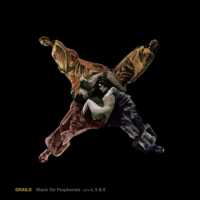 Grails: Black Tar Prophecies, Vol. 4, 5 & 6 (Temporary Residence, 10/1/13)
Grails: Black Tar Prophecies, Vol. 4, 5 & 6 (Temporary Residence, 10/1/13)
“Self-Hypnosis”
Aping ‘60s-era psych music has become a bit of a cliché – it seems like just about everyone from old punks to young upstarts just discovering their grandparents’ record collections, at some point, grow their hair and a terrible mustache and go through a Hawkwind-worship phase. What most of them miss, however, is that it was the organic newness and spectacle of those bands that made them so appealing. It can’t be emulated, which is exactly the thing that makes the term so fitting and at the same time so confusing for Grails.
The band sounds like five talented musicians from disparate schools of music got together and tried to make something happen. The result is weird, no question, but beautiful and almost cinematic. Guitars and banjos brush up against exotic Eastern instruments while a full drum kit or a single tambourine can lay down the beat. Black Tar Prophecies Vol. 4, 5 & 6 collects the last two volumes in the Black Tar series with the addition of some unreleased material. True to form, the material here is worlds away from what Grails has done in the past, and at the same time typical of its immense creativity and devotion to progression.
That’s what the psych movement was about, and with this record, Grails affirms its torchbearer status.
– Oakland L. Childers
 Deltron 3030: Event II (Bulk, 10/1/13)
Deltron 3030: Event II (Bulk, 10/1/13)
“Melding of the Minds”
Deltron 3030: “Melding of the Minds”
It’s been a long wait for fans of Deltron 3030, the science-fiction-themed rap super-group of Del the Funky Homosapien, Dan the Automator, and Kid Koala — 10 years if you go by Joseph Gordon-Levitt’s opening monologue or 80 if you believe Deltron Osiris, the new character introduced on this album. Either way, time has moved on, and things seem to have taken a turn for the worse in Deltron’s world — not that you’d know it from the generally upbeat flow of Event II.
There’s a lot of looking back (courtesy of David Cross and girlfriend Amber Tamblyn, as well as Lonely Island, who provide one of the brightest if not corniest interludes) and not much moving forward. Though Del still has the smoothest flow in the business and Automator remains peerless among producers, the best cuts on Event II are the ones that harken to Gorillaz (“What Is This Loneliness,” featuring Damon Albarn and Casual) and Dr. Octagon (“Talent Supercedes,” featuring Black Rob). Event II is the most creative rap record in ages, but — as its production began in 2004 — it conducts its own type of time travel.
– Oakland L. Childers
 Chrome Hoof: Chrome Black Gold (Cuneiform, 10/8/13)
Chrome Hoof: Chrome Black Gold (Cuneiform, 10/8/13)
“When the Lightning Strikes”
Chrome Hoof: “When The Lightning Strikes”
Proving that the worlds of dirge-laden doom metal and electro-funk death-disco are less than a stone’s throw away, London’s Chrome Hoof prog it up and mix genres into a synth-heavy corkscrew of operatic — er, opera-erratic — rock music on its fourth full-length, Chrome Black Gold.
An ever-expanding psychedelic sci-fi orchestra helmed by Leo Smee (of Cathedral), Chrome Hoof on this album has tapped vocalist Shingai Shoniwa of UK indie rockers Noisettes as a guest on four tracks. Similar to that of Royal Thunder’s Miny Parsonz, Shoniwa’s voice is powerful but sultry.
On “Varkada Blues,” her hypnotic, lounge-swaying enunciations are a disarming foil to the guttural growls of another guest — Jeff Walker, the current bassist/vocalist of Carcass. The song is a good example of the genre blending for which the band is known; everything comes together in a brutal, other-worldly-sounding but entirely danceable, six-minute mix permeated by metronomic synthesizers that carry listeners through the outro. Another standout is “When the Lightning Strikes,” on which Shoniwa’s voice swoops like a vulture out of dark clouds amid a metallic but deeply classical crunch reminiscent of the Fucking Champs.
Overall, Chrome Black Gold collapses space and time and pries open listeners minds, continuously whetting them for the weird.
– Brendan Dabkowski
 Anna Calvi: One Breath (Domino, 10/8/13)
Anna Calvi: One Breath (Domino, 10/8/13)
“Sing to Me”
Singer-songwriter Anna Calvi’s new album sports a photo of Calvi, thick eye makeup running, rain pouring down her face, staring with intensity into the camera — an image that some would consider over the top, even in the overwrought world of album covers. But when the first stunning notes sound, it seems as though the photographer didn’t go far enough.
Calvi, who debuted in 2011 with an excellent self-titled record, has a depth to which most only can aspire. Her voice and guitar are a seductive pairing, with sexuality boiling through dirty fuzz and vocals topping songs that wear her love of classical music proudly. The title track is a paranoiac’s love song — tension played by a driven beat, with spectacular string accompaniment from Placebo’s Fiona Brice. Later, closer “The Bridge” is an icy and operatic stunner, marked by otherworldly vocals in a Northern cathedral.
Calvi has not lost any momentum on this second album. Her balladry, halfway between torch songs and sweat-soaked garage rock, is unimpeachable. Breathe it in.
– Lincoln Eddy
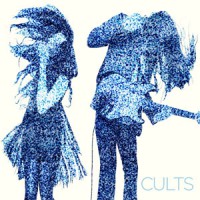 Cults: Static (Columbia, 10/15/13)
Cults: Static (Columbia, 10/15/13)
“I Can Hardly Make You Mine”
Cults: “I Can Hardly Make You Mine”
Following the success of their breakthrough self-titled debut, multi-instrumentalist Brian Oblivion and singer Madeline Follin are back with their sophomore effort,Static. The album comes on the heels of Oblivion and Follin’s breakup, a result of the strenuousness they encountered while balancing lengthy touring with heightened success.
But even with that life change in the mix, the duo hasn’t missed a beat, composing an album that is just as catchy, menacing, and all-around gorgeous as their debut. Standout tracks such as “High Road,” “I Can Hardly Make You Mine,” and “So Far” showcase a remarkable skill set for crafting dark and demented pop gems.
– Michael Danaher
 So Hideous: Last Poem / First Light (self-released, 10/22/13)
So Hideous: Last Poem / First Light (self-released, 10/22/13)
“Rising”
Fusions, crossovers, and poly-influenced musical projects were abundant before the Internet became accessible to most, but the Information Age has yielded an entire generation of musicians who are exposed to whatever they’re interested in hearing. It has produced a “post-everything” type of mindset, and NYC quartet So Hideous is an exciting product of these times.
Formerly So Hideous, My Love, this symphonic blackened hardcore band is as inspired by post-black-metal outfit Celeste as by post-rock giant Mono and minimalist composers Philip Glass and Arvo Pärt. Now, with its debut “full-length” (27 minutes), the quartet expands its orchestral reach, enlisting the studio aid of The First Light Orchestra, a collection of 10 string players, a tuba, and four vocalists.
Last Poem / First Light opens with a Dimmu Borgir-esque piece of haunting and terrifying symphonic metal, propelled by heaps of double bass before falling into an eerie, barely there outro. “Stabat Mater” follows with a dark intro comprised of bells, operatic vocals, clean guitar, and rising cymbals. A mere minute passes before the band explodes with a full-bore blast of blackened hardcore — an eruption of anger that yields the song’s close to a sad piano passage.
The rest of Last Poem / First Light is a similar swing of emotions, but it’s always a sonic punch in the gut. Quite simply, it’s one of the most exciting debut LPs of the year.
– Scott Morrow
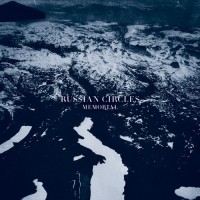 Russian Circles: Memorial (Sargent House, 10/29/13)
Russian Circles: Memorial (Sargent House, 10/29/13)
“Deficit”
From start to finish, Russian Circles’ fifth album, Memorial, whips listeners back and forth through dark thunderheads into blinding sunlight. The Chicago post-metal three-piece carefully adjusts its compositional tint, forcing listeners to surface in a winter scene — as beautiful as it is harsh — of some imagined past or future.
Whether it’s through Mike Sullivan’s increasingly adept guitar looping or layering, or both, or Dave Turncrantz’s spot-on percussion bouncing off of, or replying to, Brian Cook’s deeply texturized bass tones, the band achieves such a relentlessly expansive and, at the same time, tight sound here that Memorial is sure to become a genre touchstone.
Exploding out of the last seconds of bright opener “Memoriam,” second effort “Deficit” recalls post-metal performer Isis’s excellently grim “So Did We” (Panopticon) sans vocals. “Deficit” ends with strands of synthesized noise and disembodied voices that cut nicely into “1777,” a seven-minute-plus piece that starts to sound like the soundtrack to a David Lynch film, with a thrust of metallic scuzz.
As it did on Empros (2011), Russian Circles employs a vocalist (this time Chelsea Wolfe) on its last number, “Memorial,” giving the song a washed-out Mazzy Star vibe complete with soupy reverb. It’s the perfect bookend to an album that’s meant to be heard in full, and to prepare you for the emotional peaks and valleys that winter conjures.
– Brendan Dabkowski
 Mutation: Error 500 (Ipecac, 10/29/13)
Mutation: Error 500 (Ipecac, 10/29/13)
“Relentless Confliction”
Mutation: “Relentless Confliction”
What do you get when you throw Napalm Death’s Shane Embury and Jon Poole of The Cardiacs into a blender with the likes of Merzbow and none other than The Fall’s Mark E. Smith? (Yes, you read that correctly.) The answer is this debut album by the “eight-man beast” working under the aptly chosen band name Mutation.
Predictably, the PR for this album hypes it as some of the most out-there shit in extreme music today. What’s actually most audacious about this music, though, isn’t its frequent twists and turns through a barrage of genres but how cohesively it all comes together. Error 500 proves that, after decades of spazzing out, the most revolutionary thing that underground musicians can do is focus. The fact that the personnel on this album can communicate in the first place — to say nothing of breaking new ground and making it listenable — counts as nothing less than a miracle.
– Saby Reyes-Kulkarni
 Big Business: Battlefields Forever (Gold Metal, 10/31/13)
Big Business: Battlefields Forever (Gold Metal, 10/31/13)
“Chump Chance”
Like potters throwing clay atop a spinning wheel and controlling its rotation to shape formless soil into adorned, reinforced rock, Seattle’s Big Business uses the basics — drums, guitar, bass — to kick up a hefty storm of accessibly intense rock ’n’ roll.
Battlefields Forever, the band’s fourth full-length, is the usual mix of riff-heavy, brooding stoner rock stretched over warm pop hooks and a penchant for the ridiculous. The fourth track, “Trees,” begins with foreboding synth-esque sounds but quickly expands into a larger-than-human-life opus with at least four memorable guitar patterns. Bass player / singer Jarred Warren chimes in with his trademark raspy yowl, “Those trees…those trees live forever!” Later track “Heavy Shoes” is a punchy rumination on the working day with a guest vocalist. “Doomsday, Today!” finds Warren opining about monkeys as new guitarist Scott Martin shreds and drummer Coady Willis makes it sound like he’s playing no less than two full kits.
Battlefields Forever is equal parts humor and intensely delivered stoner gloom, which is evidenced in the album’s last track, “Lonely Lyle.” It’s a sort of sad march through a battlefield of ghosts, but it also manages to recall the sappy imagery of Led Zeppelin or Rush — but with the gritty delivery of the Melvins (of which Willis and Warren are a part).
– Brendan Dabkowski
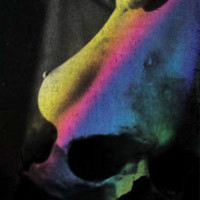 Vaura: The Missing (Profound Lore, 11/12/13)
Vaura: The Missing (Profound Lore, 11/12/13)
“Incomplete Burning”
The new album from experimental Brooklyn, NY, metal band Vaura — consisting of members of Dysrhythmia, Gorguts, and Kayo Dot — is a spattering blast of rain against blotchy windows. Songs that initially seem to strip off layers of surface grime eventually reveal only roiling, blackened skies of a rapidly darkening world.
The four-minute title track begins with a black-metal airiness reminiscent of Wolves in the Throne Room before diving into mid-tempo gothic haziness and then finishing with a 20-second assault of blast-beat shoegaze, amid Joshua Strawn’s buried — but very melodic — darkwave delivery.
A few songs on The Missing are marked by almost subconscious black-metal-style backing vocals, making things distant and creepy. “Mare of the Snake” and “Passage to Vice” juxtapose light and dark. The former features effects-heightened gothic wailing that slices into a melodic chorus, while in the latter a barely perceptible evil growl backdrops bright, clean-guitar fingerpicking.
The song “Abeyance” wanders into the progressive instrumental territory inhabited by bands like Maserati; the track begins with a fog crunch of shrieking instruments and vocals, drifts to psychedelia, and finishes with synths peeling out in a long, dark corridor.
Though The Missing may not be Vaura’s most cohesive effort, fans of moody, experimental metal will find plenty to enjoy.
– Brendan Dabkowski
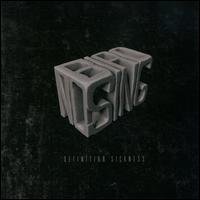
No Bird Sing: Definition Sickness (Strange Famous, 11/12/13)
“Don’t Think” (f. Sage Francis)
Strange Famous Records, the label started by Sage Francis, has a hell of a stable. Cecil Otter, B. Dolan, Buck 65…and with a metal-darkened, addictively beat-driven debut, you can add Minnesota hip-hop group No Bird Sing to that list.
No Bird Sing is the brainchild of rapper Joe Horton, guitarist Robert Mulrennan, and drummer Graham O’Brien. Going from a live-band aesthetic to a more production-heavy recorded model has the potential to alienate fans, but No Bird Sing’s Definition Sickness is a dark pleasure. With a voice that recalls a more disillusioned Aesop Rock (if such a thing is possible), Horton raps over droning guitar and organic beats — the traditional instrumentation not competing with electronic production but rising to the top.
The album will evoke different things in different listeners. You may hear heaviness, drone, ambient techno, or modern indie rock, all lovingly filtered through the lens of hip hop. There’s no telling which interpretation is correct, but the end result is a nice fourth-quarter surprise, one of the best rap albums of the year.
– Lincoln Eddy
 Secret Chiefs 3: Book of Souls: Folio A (Web of Mimicry, 11/26/13)
Secret Chiefs 3: Book of Souls: Folio A (Web of Mimicry, 11/26/13)
“Balance of the 19”
Secret Chiefs 3: “Balance of the 19”
Some bands change your life; some bands change your worldview; some bands change the very way that you hear music, forever altering your understanding of what can be achieved. Secret Chiefs 3 accomplishes all of these things and more, and with the first half of its long-awaited Book of Souls — the second piece in an epic “mega-trilogy” that began with 2004′s Book of Horizons — the indefinable fusion masters (led by Mr. Bungle guitarist Trey Spruance) make good on a decade on anticipation.
Amazingly, most of these songs began being tracked from 2003 to 2006, with more and more layers added every few years by a slew of talented members and guests. Each regular-length track is interspersed with “suprasensory radio spots,” blasts of melodic and rhythmic bliss/adrenaline that last anywhere from 20 seconds to two minutes — and that give a taste of new drummer Kenny Grohowski, a technical dynamo who must be seen live to be believed.
The most widely circulated track herein is the spruced-up rendering of theHalloween theme, a live favorite that was released via seven-inch in 2007. Though a creepy, head-banging standout, it’s least representative of the album — one that, this time around, draws more from early American classical influence than Middle Eastern. This is most evident in the above-mentioned “radio spots” as well as mini-masterpieces “Potestas Clavium” and “Scorched Earth Saturnalia,” the latter being a seven-minute “ballet miniatures suite in four elemental movements.”
Calling “Saturnalia” a masterful epic would be an understatement. It’s one of the album’s greatest and most tightly wound pieces, set up with racing pizzicato strings and bells, a thumping dance beat, and haunting operatics before flutes, piano, strings, and snares all march in lockstep. The rest is an interwoven audio puzzle, with bassoon, strings, piano, harpsichord, operatic vocals, and harp dancing around, through, and atop one other.
Later, the album presents a Chiefs rarity: a vocal-based track, sung by none other than former Mr. Bungle colleague Mike Patton. This alternative version of Jacques Brel‘s “La Chanson de Jacky,” a song that was popularized in the United States by Scott Walker, too was released in limited seven-inch form, but the LP version includes instrumental additions of flute and harp.
Book of Souls: Folio A easily vies for album of the year…and that’s without the upcoming Folio B. Miss this at your music collection’s peril.
– Scott Morrow
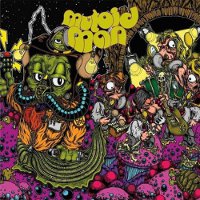 Mutoid Man: Helium Head (Magic Bullet, 11/26/13)
Mutoid Man: Helium Head (Magic Bullet, 11/26/13)
“Gnarcissist”
There’s clearly something in the Boston area’s water, and it’s a good bit stronger and weirder than tea. Already having affected Doomriders and Zozobra this year, the mystery substance has clearly made its way into the systems of Stephen Brodsky (Cave In) and Ben Koller (Converge), collectively Mutoid Man.
On their debut outing, Helium Head, the pair exhibit a similar ferocity and tempotic abandon as the aforementioned bands, plowing through seven songs (including a killer Animals cover) in about the time that it takes to boil an egg. Yet true to form, Brodsky doesn’t let the music dictate his vocal style, growling occasionally but for the most part lilting along harmoniously to the guitar’s lead, while Koller pounds away as violently as a machine gunner but with the precision of a sniper.
Whatever demons have invaded these two men clearly aren’t the kind that are easily exorcised, but the pair does its best, making Helium Head one of the most blistering yet complex records of the year.
– Oakland L. Childers
—
Honorable Mentions
Cult of Luna: Vertikal (Density, 1/29/13)
Buke & Gase: General Dome (Brassland, 1/29/13)
Helen Money: Arriving Angels (Profound Lore, 2/5/13)
Pissed Jeans: Honeys (Sub Pop, 2/12/13)
PVT: Homosapien (Felte, 2/12/13)
Nick Cave & The Bad Seeds: Push the Sky Away (Bad Seed Ltd., 2/19/13)
Dan Friel: Total Folklore (Thrill Jockey, 2/19/13)
Mikrokolektyw: Absent Minded (Delmark, 2/19/13)
Atoms for Peace: Amok (XL, 2/26/13)
Wild Belle: Isles (Columbia, 3/12/13)
Squarepusher: Enstrobia EP (Warp, 3/11/13)
Marnie Stern: The Chronicles of Marnia (Kill Rock Stars, 3/19/13)
KEN Mode: Entrench (Season of Mist, 3/19/13)
Phosphorescent: Muchacho (Dead Oceans, 3/19/13)
Inter Arma: Sky Burial (Relapse, 3/19/13)
Sexmob: Cinema, Circus & Spaghetti (Sexmob Plays Fellini: The Music of Nino Rota) (The Royal Potato Family, 3/19/13)
Kvelertak: Meir (Roadrunner, 3/26/13)
Depeche Mode: Delta Machine (Columbia, 3/26/13)
Wavves: Afraid of Heights (Mom + Pop / Warner Bros., 3/26/13)
The Black Angels: Indigo Meadow (Blue Horizon, 4/2/13)
Brown Bird: Fits of Reason (Supply & Demand, 4/2/13)
Mike Patton: The Place Beyond the Pines soundtrack (Milan, 4/9/13)
Como Asesinar a Felipes: Comenzará de Nuevo (Koolarrow, 4/9/13)
The Flaming Lips: The Terror (Warner Bros., 4/16/13)
Stephen Brodsky: Hit or Mystery EP (Little Black Cloud, 4/16/13)
John Parish: Screenplay (Thrill Jockey, 4/16/13)
Beastwars: Blood Becomes Fire (Destroy, 4/23/13)
Lilacs & Champagne: Danish & Blue (Mexican Summer, 4/23/13)
Melvins: Everybody Loves Sausages (Ipecac, 4/30/13)
Coliseum: Sister Faith (Temporary Residence, 4/30/13)
Colin Stetson: New History Warfare Vol. 3: To See More Light (Constellation, 4/30/13)
Sole: No Wising Up, No Settling Down (5/1/13)
AM & Shawn Lee: La Musique Numérique (Park the Van, 5/7/13)
Vampire Weekend: Modern Vampires of the City (XL, 5/14/13)
Cultura Tres: Rezando al Miedo (Devouter, 5/14/13)
Survival: s/t (Thrill Jockey, 5/14/13)
Jaga Jazzist: Live with Britten Sinfonia (Ninja Tune, 5/14/13)
Man or Astro-Man?: Defcon 5…4…3…2…1… (Communicating Vessels / Chunklet, 5/21/13)
The Andreas Kapsalis & Goran Ivanovic Guitar Duo: Blackmail (6/4/13)
Pokey LaFarge: s/t (Third Man, 6/4/13)
Sao Paulo Underground: Beija Flors Velho e Sujo (Cuneiform, 6/4/13)
Noxious Foxes: Epochalypso (self-released, 6/4/13)
Deveykus: Pillar Without Mercy (Tzadik, 6/18/13)
Quasimoto: Yessir, Whatever (Stones Throw, 6/18/13)
Bill Frisell: Big Sur (OKeh, 6/18/13)
Rose Windows: The Sun Dogs (Sub Pop, 6/25/13)
Bosnian Rainbows: s/t (Sargent House, 6/25/13)
Louise Burns: The Midnight Mass (Light Organ, 7/9/13)
True Widow: Circumambulation (Relapse, 7/23/13)
Zorch: Zzoorrcchh (Sargent House, 7/23/13)
Washed Out: Paracosm (Sub Pop, 8/13/13)
Ty Segall: Sleeper (Drag City, 8/20/13)
Jel: Late Pass (Anticon, 8/20/13)
Julianna Barwick: Nepenthe (Dead Oceans, 8/20/13)
Zola Jesus & JG Thirlwell: Versions (Sacred Bones, 8/20/13)
Gorguts: Colored Sands (Season of Mist, 9/3/13)
Volcano Choir: Repave (Jagjaguwar, 9/3/13)
Arctic Monkeys: AM (Domino, 9/10/13)
God Is an Astronaut: Origins (Rocket Girl, 9/17/13)
Cacaw: Stellar Power (Skirl, 9/17/13)
Deer Tick: Negativity (Partisan, 9/24/13)
Melt-Banana: Fetch (A-Zap, 10/1/13)
RJD2: More Is Than Isn’t (RJ’s Electrical Connections, 10/8/13)
Kevin Hufnagel: Ashland (self-released, 10/8/13)
Doomriders: Grand Blood (Deathwish, 10/15/13)
Foetus: Soak (Ectopic Ents, 10/15/13)
Red Fang: Whales and Leeches (Relapse, 10/15/13)
Pelican: Forever Becoming (Southern Lord, 10/15/13)
Marijuana Deathsquads: Oh My Sexy Lord (Totally Gross National Product, 10/15/13)
Mikael Jørgensen & Greg O’Keeffe: s/t (Butterscotch, 10/15/13)
Spindrift: Ghost of the West soundtrack (Tee Pee, 10/22/13)
Sepultura: The Mediator Between Head and Hands Must Be the Heart (Nuclear Blast, 10/29/13)
Son Lux: Lanterns (Joyful Noise, 10/29/13)
Los Melvins: Tres Cabrones (Ipecac, 11/5/13)
Mark Orton: Nebraska soundtrack (Milan, 11/19/13)

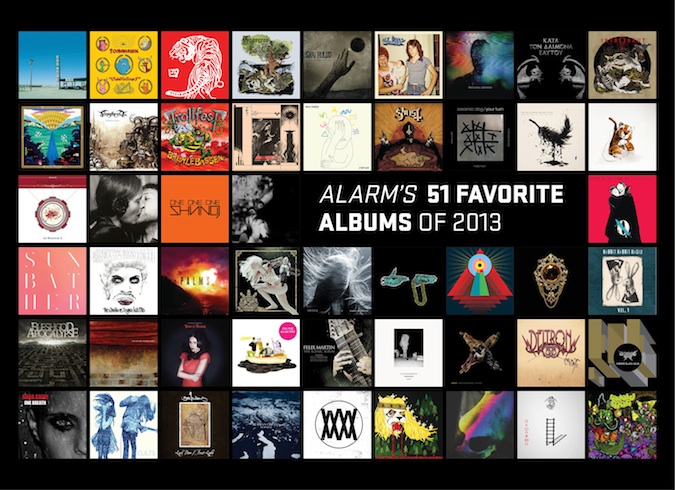

1. The Ocean – Pelagial LP Box Set
2. Motorpsycho – Still Life with Eggplant LP
3. Milk+ – Band on Wire mp3…
4. Queens of the Stone Age – Like Clockwork LP (3x different versions) + CD
5. And So I Watch You From Afar – All Hail Bright Futures LP
6. Vista Chino – Peace LP
7. Persefone – Spiritual Migrations mp3…
8. Anciients – Heart of Oak LP
9. Fuzz – Fuzz LP
10. Black Sabbath – 13 LP
11. Scale the Summit – The Migration LP
12. Mutoid Man – Helium Head mp3, LP on order.
13. Deafheaven – Sunbather LP
14. Pelican – Forever Becoming LP
15. Sandrider – Godhead LP
16. The Old Wind – Feast on Your Gone LP
17. Kylesa – Ultraviolet LP
18. Palms – Palms LP
19. Touche Amore – Is Survived By LP
20. Intronaut – Habitual Levitations mp3, LP on order.
21. Red Fang – Whales and Leeches mp3, LP on order
22. Kverlertak – Meir LP
23. Sithu Aye – 26 EP digital only
24. Stonehenge – Bunch of Bisons mp3..
25. The Dillinger Escape Plan – One Of Us Is The Killer LP
Interesting list, with amazingly great overlaps in the categories “have” “want to have” and “know”
Los Melvins, very clever…